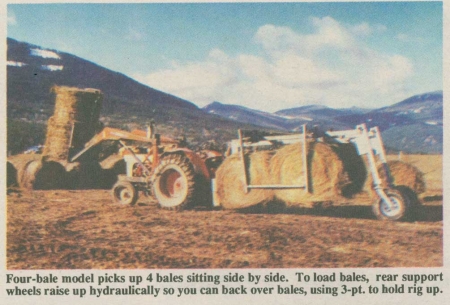
Robert Vickaryous, Porthill, Idaho, can haul six big round bales at a time using a loader tractor and his new "over-the-top" bale retriever.
The 3-pt. mounted 4-bale retriever unit works together with a 2-bale loader fork. Vickaryous uses the bale fork to set groups of 4 bales together in the field. To pick up the bales with the bale retriever, he backs the unit over the bales by raising the rear wheels and support arms up in the air. Once in position over the bales, he uses hydraulics to push the side-mounted bale spear arms into the bales. Then he lowers the rear support wheels and raises the 3-pt. to lift the bales off the ground.
To unload, he lowers the 3-pt., raises the side arms, and then lifts the rear wheels and drives ahead.
He uses the loader fork to stack bales two at a time onto trucks or inside his barn, or to place them in portable bunk feeders.
"It's a simple, cost efficient way to move bales. Works terrific," says Vickaryous, who operates a cow-calf operation. "After they're unloaded, the bales are in position to pick up with the loader fork. Hauling six bales at a time saves a lot of wear and tear on my tractor and greatly increases my hay handling production.
"If bales are scattered out in the field, I can pick up 2 bales at a time with the retriever and drive to the next pair of bales and unload. Then I use the loader to stack the four bales together."
Vickaryous has also built a 2-bale model without rear support wheels. Two sets of hydraulic outlets are needed for the 4-bale model and one set for the 2-bale model. The arms on both models can be adjusted to handle 5 by 5 or 5 by 6-ft. round bales, or 4 by 5-ft. sq. bales.
The loader fork is equipped with two spears, one of which is hydraulically operated to "clamp" the two bales together. Another cylinder is used to tilt the bales forward or backward.
